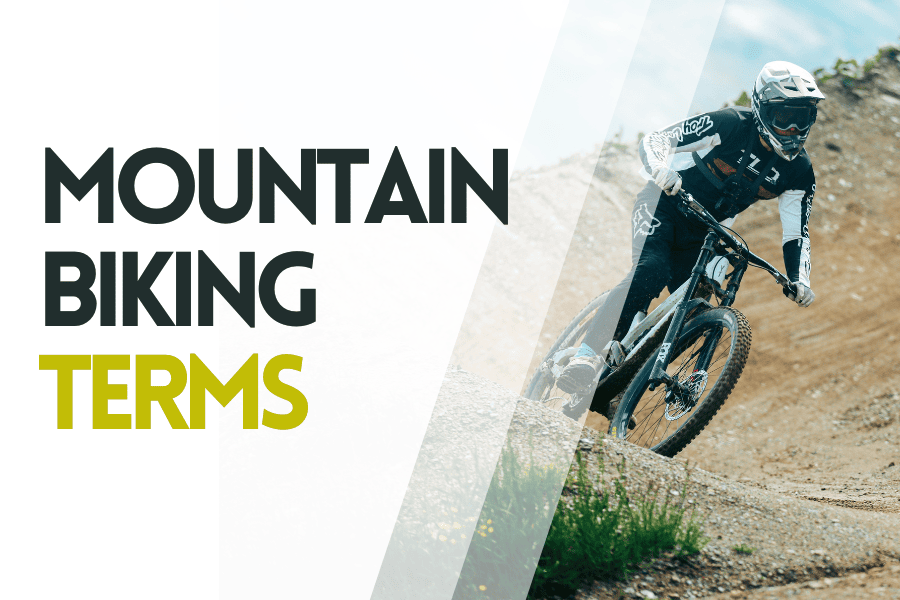Like any other community, that’s been around long enough, mountain bikers have developed their own meanings for existing words or invented completely new terms.
Anyone not on the inside of this language is easily confused by the barrage of slang thrown around.
We mountain bikers are not even using our made-up words sparsely. Instead, any one term can refer to either:
- Gear Terminology
- Trail Conditions
- Trail Features
- Emotional States
- or Actions
So, this is a glossary of terms and phrases commonly used and also found on this website. It lives and will be constantly expanded. Let’s get on with Mountain Biking Jargon from A to Z, starting with …
All-Mountain (AM)
All-mountain refers to the type of mountain biking, that’s done on a variety of terrain with an all-purpose trail bike. While uphill climbs are part of it, the downhill descends are the main focus for most riders. Also called Enduro mountain biking, technical trails and jumps are a staple.
Armpump
Arm pump and hand fatigue basically occur for the same reasons: Strenuous grip for long periods of time. The muscles responsible for tightening the grip of your fingers are located in the forearm.
They get pumped with blood to provide oxygen and that swelling of the muscles also leads to blocked blood flow, which in turn leads to numb and powerless hands, making it difficult to brake, steer the bike or even hold on.
Berm
Banked corners on mountain bike tracks are called berms or berm turns. They allow much higher cornering speeds than flat turns and can catch riders after a steep, fast section.They’re a common feature on man-made trails, bike park tracks, and pump tracks and can be built out of soil or tarmac.
Bike Park
Dedicated facilities for Downhill mountain bike riding are called Bike parks. They provide lift access with a bike, purpose-built downhill tracks, security measures and usually a bike repair shop. They’re known for their wide variety of track designs and difficulty levels up to the technically most difficult tracks.
Bike Tire Bead
The tire beads are what hold the tire on the rim. As the only part of the tire actually touching the rim, beadings are important for a tire to get right. There are different beading materials like steel, Kevlar and aramid that affect the handling in slightly different manners.
Bike Tire Casing
A tire casing is the main body of the tire and where the tire tread sits on top of. It’s constructed of one or two layers of plies of nylon cloth covered in rubber. The tire casing acts as the fundamental structure of the tire, giving it its shape, stability, flexibility and puncture protection.
Bike Tire Compounds
A bike tire compound is the rubber material the tread pattern and sidewall are made of. Single, dual, and triple compounds are common for mountain bike tires, that need to perform in various conditions. Handling differences between rubber compounds are more pronounced the harder or wetter a surface is.
Bike Tire Tread Pattern or Profile
Tread patterns on mountain bike tires are the part that digs into the ground to produce traction whereas slick tires would have limited grip. This allows MTBs to be ridden in various terrains like dirt, loose soil, mud, rocks, sand, and snow. There are optimal thread options based on conditions and riding style.
Blue Groove
The preferred riding line on a dirt track that gets hard-packed and polished by riders repeatedly going over it is referred to as “blue groove”. The name originates from motorcycle racing, where the shiny tire abrasion looks blue. In biking, blue groove can develop on downhill tracks, pump tracks or BMX courses where the track surface is hard dirt or clay.
Bottom out
Bottoming out describes a suspension part (forks and shocks) going through all its suspension travel and hitting a hard stop. This isn’t ideal since it can’t absorb any more impacts and can damage the internal mechanics. Occasional bottoming on big impacts and drops are to be expected and not too worrying.
Tires can also bottom out when the impact is big enough to push the rim so far down it touches the inside of the tire tread. Again, the tire is at its limit and can’t absorb any more shocks and the rim hits the ground. Dents and cracks in the rim or at least pinch flats are the common results. Low tire pressures or big impacts are the cause here.
Feel free to use my tire pressure calculator to find your sweet spot and prevent flat tires.
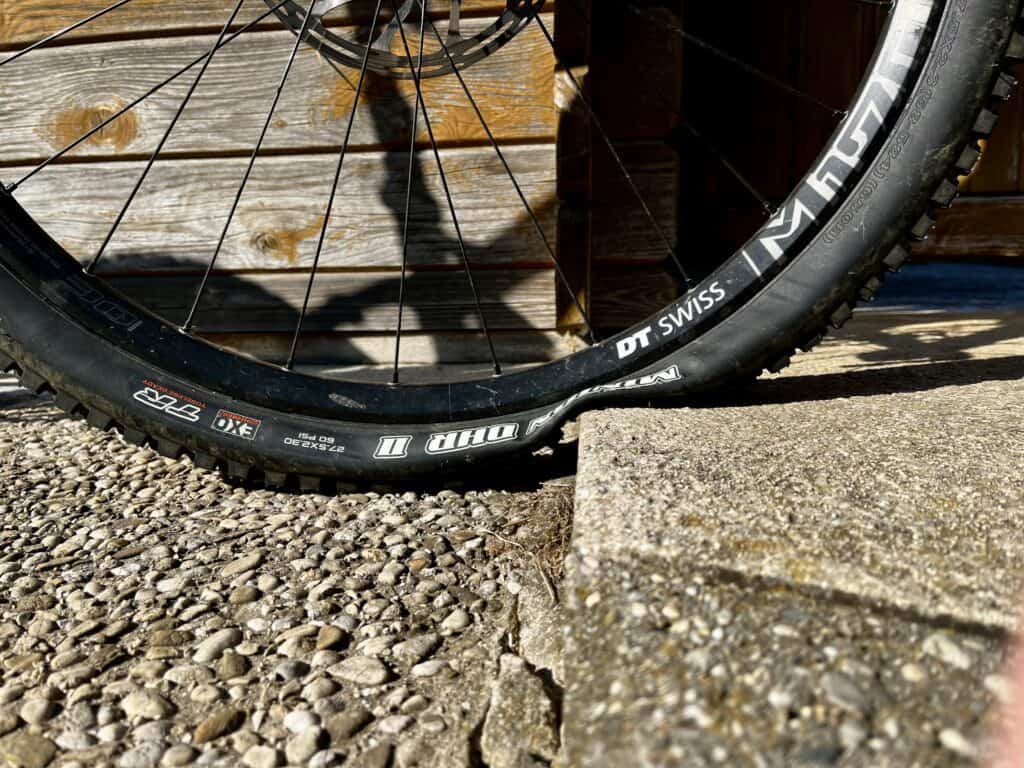
Braking Bumps
Braking bumps are the small, consecutive holes on a bike trail. They’re formed in zones where riders tend to brake and push the soil together, forming waves. The more frequented and steep a trail is, the more braking bumps are formed. They’re very common in bike parks.
The Bullet
A mountain bike helmet without a visor. Especially referring to full-face downhill helmets that have big visors. It looks odd and is often mocked.
DH racers in the 90s and early 2000s opted to go out without visors and tight skin suits for aero gains at the cost of looking completely goofy. MTB helmets have visors for a reason.
Burping a Tire
Burping a tire is when a tubeless mountain bike tire loses air pressure suddenly due to the forceful displacement of the tire’s bead from the rim caused by impacts or side loads during cornering. This can also cause the tire to partially or fully come off the rim, resulting in a loss of control and a potential crash.
Case / Casing
Verb: To case a jump means coming up short on the landing. In the case of a man-made jump this means landing on the knuckle of the landing. Mostly only the rear wheel comes up short and kicks back up because of the hard landing.
Noun: The bike tire casing is the main structure and protective layer that provides form and stability to the tire. It is usually made of nylon, kevlar or other durable materials that can withstand rough terrain and prevent punctures.
Chain guide
A device that helps to keep the bike chain in place, preventing it from falling off or bouncing around too much while riding over rough terrain.
Chicken Line
In mountain biking, a Chicken Line is an easier alternative line or detour around a tough obstacle or section on the trail.
It’s like a safe option for riders who aren’t quite ready to tackle the big jumps or drops. Beginners or those not feeling super confident can still enjoy a trail without the risk and gradually build up their skills.
Plus, it’s a smart way to stay safe while pushing your limits at your own pace.
Clear / Clearing
To clear a jump means landing in the preferred landing area. These are the downslopes or landing transitions, that minimize the impact upon landing and allow for smooth jumps.
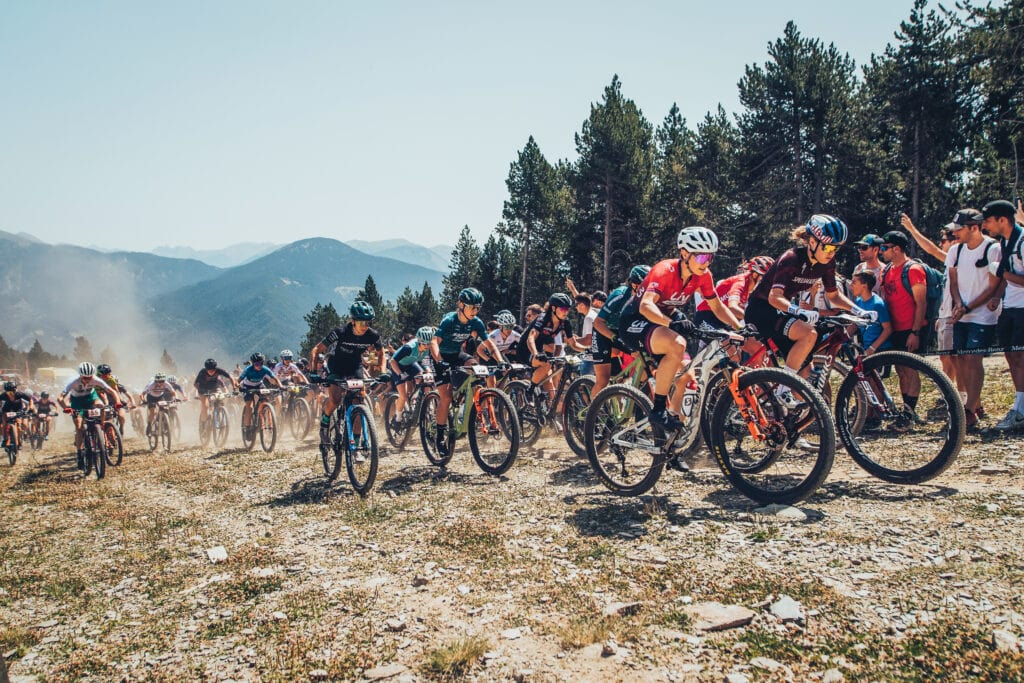
Cross Country (XC)
Cross Country is the oldest and most popular mountain biking discipline. It’s the least technical in terms of terrain, but the most exhausting as it involves lots of climbing uphill and mellow singletracks downhill. XC races can be held on point-to-point tracks or looped courses.
Dab / Dabbing
To dab is to remove one foot off the pedal to push against the ground in order to prevent a crash and regain balance. The foot is then quickly placed back on the pedal to regain control.
Removing both feet at once isn’t dabbing anymore, that’s paddling.
Dropper post
A type of seatpost that can be adjusted while riding, allowing the rider to quickly and easily lower or raise their saddle height depending on the terrain. A dropper seat post is usually found on trail and enduro bikes that can go uphill but also descend well.
DH and XC bikes generally don’t have dropper posts.
Enduro Gap
An MTB fashion faux-pas where there’s a gap between the end of MTB shorts and the knee pad, exposing thigh skin. Often pale on MTBers, it gets all kinds of unwanted attention. So, be sure to always wear the appropriate length MTB shorts!
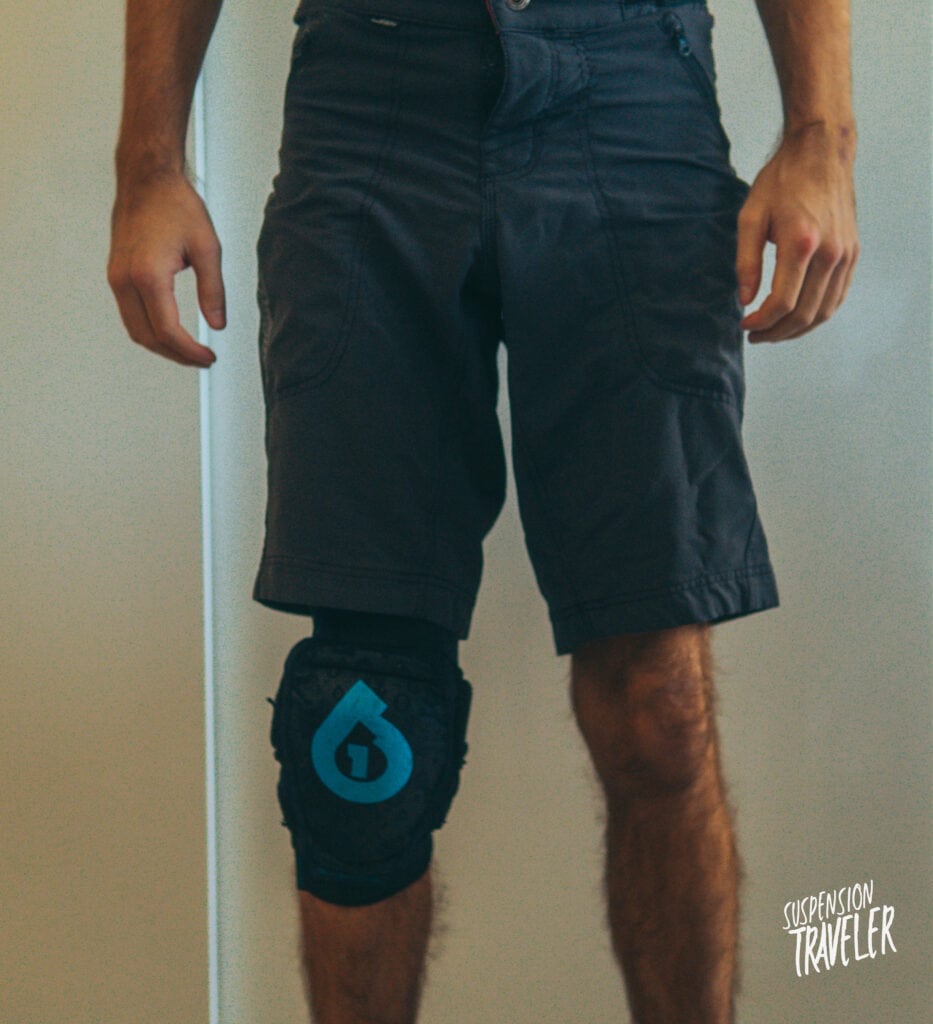
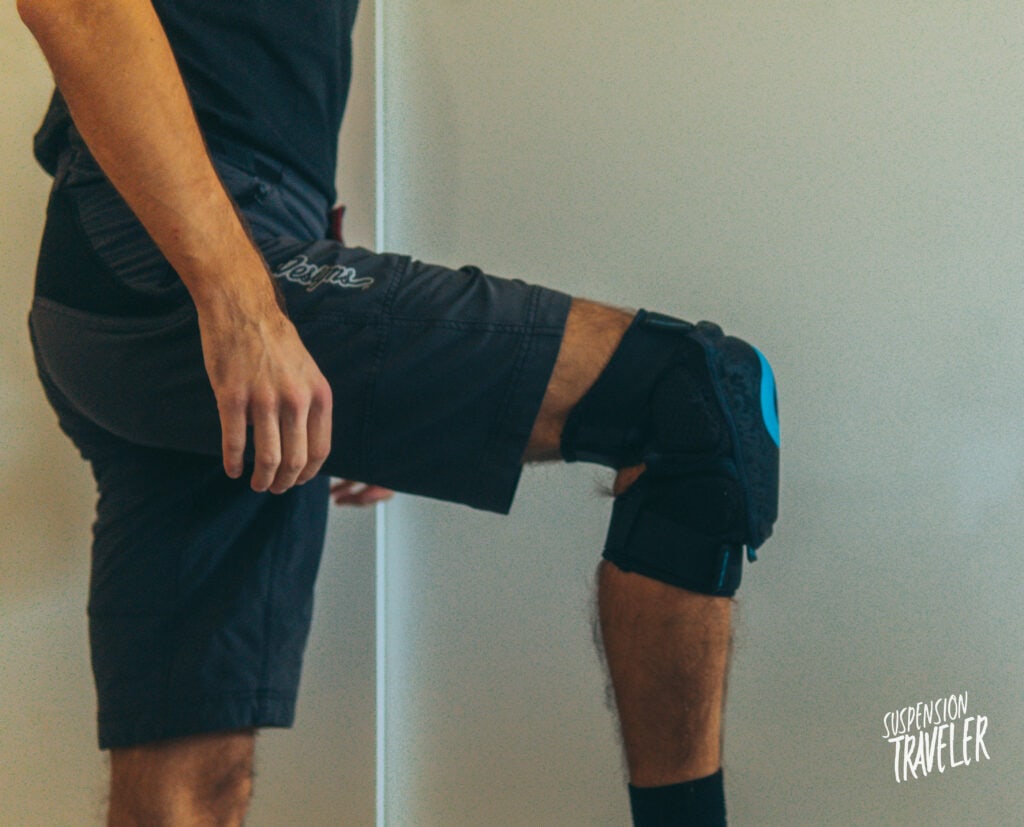
Not only a fashion crime, but also distracting while riding.
Flow trail
A type of trail that’s designed to flow without much pedaling or braking. That’s achieved by a smooth trail surface, wide berm turns and optional jumps. This allows riders to maintain their momentum and flow through corners, rather than having to slow down and carefully pick lines.
Full-Squish
“Full squish” is another term for full-suspension bikes, which is a type of mountain bike that has both front and rear suspension elements: a foront fork and a rear shock. The use of dual suspension allows the bike to maintain better traction and control, making it suitable for more technical and challenging trails.
Huck / Hucking
A big jump that requires excess speed or a big pull on takeoff. That can be a regular double jump, drop or gap – sometimes without a proper landing. Hucking a jump is often the opposite of smooth and fast but can be very impressive, even stylish. Going big never gets old.
Knuckle
The top edge of a jump’s landing. Pronounced (meaning sharp-edged) knuckles take more precision and risk to land perfectly. Mellow knuckles are also called case pads because they allow riders to come up a little short on the landing and “case the jump” relatively safely.
Lily pad
Hop on hop off jump feature
Line
The chosen path that a rider takes through a section of trail. It’s often determined by the natural obstacles of the terrain or the placement of obstacles like roots, rocks and turns. The harder a trail, the more mandatory line choice is and the more narrow each feasible line is.
Lip
A jump lip is the edge of the jump face and the point at which the tires leave the ground. The sharper the lip, the more predictable the jump.
Loamer
Loam is the dark, loose soil only found on fresh natural mountain bike trails. It’s a particularly pleasant feeling to ride on, like powder snow in winter sports. However, it can’t be produced or re-created. Once a track is bedded in, the soft loamy surface is gone and the harder base remains.
Also called brown pow or brown gold. Example sentence:
LOAMER!
Mr. Ed Masters
MTB
Mountain Biking or Mountain Bike.
Off-Camber
In mountain biking, an off-camber is one where the slope of the trail tilts to the side rather than being level. This can make it more difficult to maintain balance and control, as the tires’ side knobs touch the ground instead of the center tread. Riders need to adjust their body position to compensate for this.
To ride an off-camber trail, riders will need to adjust their body position and technique to maintain balance and control. This may involve leaning into the slope of the trail, shifting their weight over the outside pedal, or using countersteering to maintain balance.
Riding off-camber trails can be a fun and rewarding challenge as it requires good balance, control, and looking ahead. Off-camber sections have become rare in man-made bike parks but can often be found on natural trails.
Pumptrack
Pumptrack is a bicycle discipline where speed is generated by pumping instead of pedaling. This is done on special circuit courses featuring obstacles like rollers, berm turns and jumps. The track design favors small, rigid bikes that roll well on hard, smooth surfaces.
Schralping
Slang for aggressively carving through turns, often leaving a visible “schralp” mark in the dirt.
Seatpost, Seat-Tube and Seat-clamp
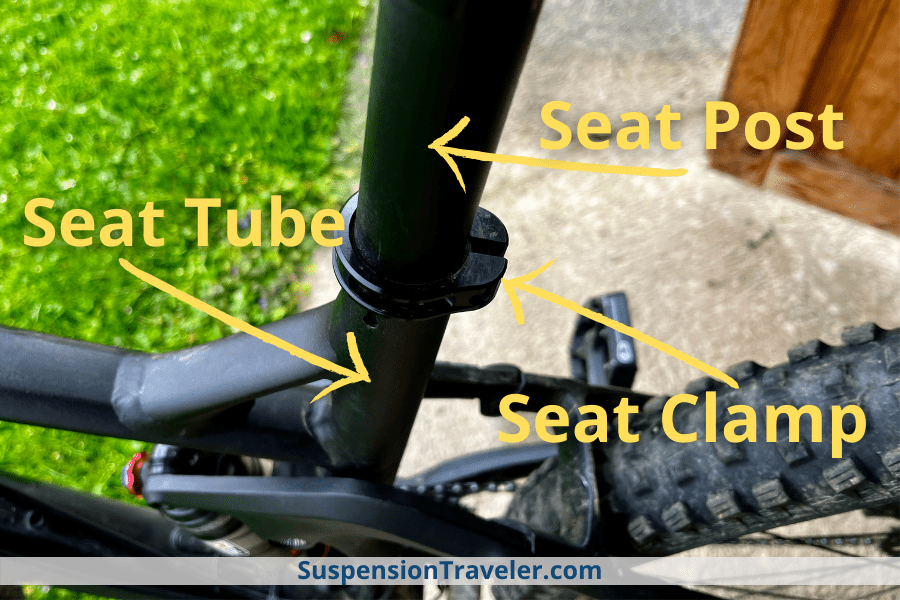
Shamy
Formerly known as chamois. The padded inserts in bib shorts to prevent chafing and provide a more comfortable seat.
Snakes
Roots = snakes
Wet roots = slippery snakes
Hard-to-see, hidden roots = sniper roots
In any case, finding yourself amongst a pit of snakes is never good.
Suspension Travel
The total distance a bike’s wheels can move vertically by compressing suspension components is called suspension travel. For rear suspensions, the total stroke of the shock is different than the rear suspension travel due to frame kinematics.
Steeze
Slang for style and ease, often used to describe a rider’s smooth and effortless-looking movements on the bike.
Visors and Peaks
Off-road helmets in general, and Mountain bike helmets in particular, do have a distinct look. They’re easily recognizable from helmets used in any other cycling discipline due to a visor – coined as “peak”. This is basically a removable shield out of plastic or carbon attached to the front of the helmet.
Protection against sun glare, rain, branches, trail debris and impact absorption is what a peak on a mountain bike helmet is for. Also called a visor, it helps in keeping anything from hitting the biker’s face and eyes, even the ground. By tilting the head downwards, the effectiveness of the shield is increased.
Whip
A type of jump where the rider kicks their bike out to the side, often performed as a trick or for style points.

